-

新人教版高中英语选修2Unit 1 Science and Scientists-Learning about Language教学设计
Step 7: complete the discourse according to the grammar rules.Cholera used to be one of the most 1.__________ (fear) diseases in the world. In the early 19th century, _2_________ an outbreak of cholera hit Europe, millions of people died. But neither its cause, 3__________ its cure was understood. A British doctor, John Snow, wanted to solve the problem and he knew that cholera would not be controlled _4_________ its cause was found. In general, there were two contradictory theories 5 __________ explained how cholera spread. The first suggested that bad air caused the disease. The second was that cholera was caused by an _6_________(infect) from germs in food or water. John Snow thought that the second theory was correct but he needed proof. So when another outbreak of cholera hit London in 1854, he began to investigate. Later, with all the evidence he _7_________ (gather), John Snow was able to announce that the pump water carried cholera germs. Therefore, he had the handle of the pump _8_________ (remove) so that it couldn't be used. Through his intervention,the disease was stopped in its tracks. What is more, John Snow found that some companies sold water from the River Thames that __9__________________ (pollute) by raw waste. The people who drank this water were much more likely _10_________ (get) cholera than those who drank pure or boiled water. Through John Snow's efforts, the _11_________ (threaten) of cholera around the world saw a substantial increase. Keys: 1.feared 2.when 3. nor 4.unless 5.that/which 6.infection 7.had gathered 8.removed 9.was polluted 10.to get 11. threat

新人教版高中英语选修2Unit 1 Science and Scientists-Reading and thinking教学设计
Step 5: After learning the text, discuss with your peers about the following questions:1.John Snow believed Idea 2 was right. How did he finally prove it?2. Do you think John Snow would have solved this problem without the map?3. Cholera is a 19th century disease. What disease do you think is similar to cholera today?SARS and Covid-19 because they are both deadly and fatally infectious, have an unknown cause and need serious public health care to solve them urgently.keys:1. John Snow finally proved his idea because he found an outbreak that was clearly related to cholera, collected information and was able to tie cases outside the area to the polluted water.2. No. The map helped John Snow organize his ideas. He was able to identify those households that had had many deaths and check their water-drinking habits. He identified those houses that had had no deaths and surveyed their drinking habits. The evidence clearly pointed to the polluted water being the cause.3. SARS and Covid-19 because they are both deadly and fatally infectious, have an unknown cause and need serious public health care to solve them urgently.Step 6: Consolidate what you have learned by filling in the blanks:John Snow was a well-known _1___ in London in the _2__ century. He wanted to find the _3_____ of cholera in order to help people ___4_____ it. In 1854 when a cholera __5__ London, he began to gather information. He ___6__ on a map ___7___ all the dead people had lived and he found that many people who had ___8____ (drink) the dirty water from the __9____ died. So he decided that the polluted water ___10____ cholera. He suggested that the ___11__ of all water supplies should be _12______ and new methods of dealing with ____13___ water be found. Finally, “King Cholera” was __14_____.Keys: 1. doctor 2. 19th 3.cause 4.infected with 5.hit 6.marked 7.where 8.drunk 9.pump 10.carried 11.source 12.examined 13.polluted 14.defeatedHomework: Retell the text after class and preview its language points

新人教版高中英语选修2Unit 1 Science and Scientists-Using langauge教学设计
This happens because the dish soap molecules have a strong negative charge, and the milk molecules have a strong positive charge. Like magnets, these molecules are attracted to each other, and so they appear to move around on the plate, taking the food coloring with them, making it look like the colors are quickly moving to escape from the soap.Listening text:? Judy: Oh, I'm so sorry that you were ill and couldn't come with us on our field trip. How are you feeling now? Better?? Bill: Much better, thanks. But how was it?? Judy: Wonderful! I especially liked an area of the museum called Light Games.it was really cool. They had a hall of mirrors where I could see myself reflected thousands of times!? Bill: A hall of mirrors can be a lot of fun. What else did they have?? Judy: Well, they had an experiment where we looked at a blue screen for a while, and then suddenly we could see tiny bright lights moving around on it. You'll never guess what those bright lights were!? Bill: Come on, tell me!? Judy: They were our own blood cells. For some reason, our eyes play tricks on us when we look at a blue screen, and we can see our own blood cells moving around like little lights! But there was another thing I liked better. I stood in front of a white light, and it cast different shadows of me in every color of the rainbow!? Bill: Oh, I wish I had been there. Tell me more!? Judy: Well, they had another area for sound. They had a giant piano keyboard that you could use your feet to play. But then, instead of playing the sounds of a piano, it played the voices of classical singers! Then they had a giant dish, and when you spoke into it, it reflected the sound back and made it louder. You could use it to speak in a whisper to someone 17 meters away.? Bill: It all sounds so cool. I wish I could have gone with you? Judy: I know, but we can go together this weekend. I'd love to go there again!? Bill: That sounds like a great idea!

新人教版高中英语选修2Unit 2 Bridging Cultures-Discovering useful structures教学设计
The grammar of this unit is designed to review noun clauses. Sentences that use nouns in a sentence are called noun clauses. Nominal clauses can act as subject, object, predicate, appositive and other components in compound sentences. According to the above-mentioned different grammatical functions, nominal clauses are divided into subject clause, object clause, predicate clause and appositive clause. In this unit, we will review the three kinds of nominal clauses. Appositive clauses are not required to be mastered in the optional compulsory stage, so they are not involved.1. Guide the students to judge the compound sentences and determine the composition of the clauses in the sentence.2. Instruct students to try to learn grammar by generalizing grammar rules, controlling written practice, and semi-open oral output.3. Inspire the students to systematize the function and usage of noun clause1.Instruct students to try to learn grammar by generalizing grammar rules, controlling written practice, and semi-open oral output.2.Inspire the students to systematize the function and usage of noun clauseStep1: The teacher ask studetns to find out more nominal clauses from the reading passage and udnerline the nominal clauses.

新人教版高中英语选修2Unit 3 Food and Culture-Discovering useful structures教学设计
The newspaper reported more than 100 people had been killed in the thunderstorm.报纸报道说有一百多人在暴风雨中丧生。(2)before、when、by the time、until、after、once等引导的时间状语从句的谓语是一般过去时,以及by、before后面接过去的时间时,主句动作发生在从句的动作或过去的时间之前且表示被动时,要用过去完成时的被动语态。By the time my brother was 10, he had been sent to Italy.我弟弟10岁前就已经被送到意大利了。Tons of rice had been produced by the end of last month. 到上月底已生产了好几吨大米。(3) It was the first/second/last ... time that ...句中that引导的定语从句中,主语与谓语构成被动关系时,要用过去完成时的被动语态。It was the first time that I had seen the night fact to face in one and a half years. 这是我一年半以来第一次亲眼目睹夜晚的景色。(4)在虚拟语气中,条件句表示与过去事实相反,且主语与谓语构成被动关系时,要用过去完成时的被动语态。If I had been instructed by him earlier, I would have finished the task.如果我早一点得到他的指示,我早就完成这项任务了。If I had hurried, I wouldn't have missed the train.如果我快点的话,我就不会误了火车。If you had been at the party, you would have met him. 如果你去了晚会,你就会见到他的。

新人教版高中英语选修2Unit 3 Food and Culture-Reading and thinking教学设计
The discourse explores the link between food and culture from a foreign’s perspective and it records some authentic Chinese food and illustrates the cultural meaning, gerography features and historic tradition that the food reflects. It is aimed to lead students to understand and think about the connection between food and culture. While teaching, the teacher should instruct students to find out the writing order and the writer’s experieces and feelings towards Chinese food and culture.1.Guide the students to read the text, sort out the information and dig out the topic.2.Understand the cultural connotation, regional characteristics and historical tradition of Chinese cuisine3.Understand and explore the relationship between food and people's personality4.Guide the students to use the cohesive words in the text5.Lead students to accurately grasp the real meaning of the information and improve the overall understanding ability by understanding the implied meaning behind the text.1. Enable the Ss to understand the structure and the writing style of the passage well.2. Lead the Ss to understand and think further about the connection between food and geography and local character traits.Step1: Prediction before reading. Before you read, look at the title, and the picture. What do you think this article is about?keys:It is about various culture and cuisine about a place or some countries.

新人教版高中英语选修2Unit 5 First Aid-Discovering useful structures教学设计
You have no excuse for not going.你没有理由不去。He was punished for not having finished his homework.他因未完成作业而受到惩罚。2.动词ing形式复合结构由物主代词或人称代词宾格、名词所有格或普通格加动词ing,即“sb./sb.'s+doing”构成。动词ing形式的复合结构实际上是给动词ing形式加了一个逻辑主语。动词ing形式的复合结构有四种形式:①形容词性物主代词+动词ing②名词所有格+动词ing③代词宾格+动词ing④名词+动词ingHer coming to help encouraged all of us.她来帮忙鼓舞了我们所有人。The baby was made awake by the door suddenly shutting.这个婴儿被突然的关门声吵醒了。Can you imagine him/Jack cooking at home?你能想象他/杰克在家做饭的样子吗?无生命名词无论是作主语还是作宾语都不能用第②种形式。Tom's winning first prize last year impressed me a lot.汤姆去年得了一等奖使我印象深刻。Do you mind my/me/Jack's/Jack leaving now?你介意我/杰克现在离开吗?Excuse me for my not coming on time.很抱歉我没能按时来。His father's being ill made him worried.他父亲病了,他很担心。We are looking forward to the singer's/the singer to give us a concert.我们盼望着这位歌手来给我们举办一场演唱会。
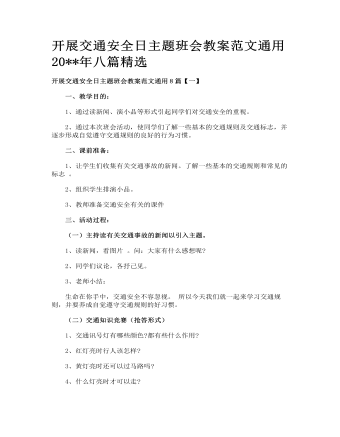
开展交通安全日主题班会教案范文通用八篇精选
骑自行车的交通安全 我国是自行车大国,许多年满12周岁的同学都骑自行车上学,骑自行车应注意哪些问题呢?下面请听一名同学朗诵《安全骑车歌》。 安全骑车歌 同学们骑自行车,听我唱段安全歌。 车铃好使闸要灵,有了情况车能停。 上街注意看信号,千万不要冒险行。 信号就是指挥员,骑车第一讲安全。 看见红灯快刹闸,该等多久等多久。 绿灯亮了才能行,安全通行不争抢。 十字路口人车多,左右观察听八方。 骑车带人危险大,攀扶车辆更可怕。 中速骑车靠右侧,分道行驶路畅通。 骑车拐弯要示意,不能猛拐一溜风。 手拉手儿把肩摸,十有八、九要撞车。 双手离把更不行,撞上汽车命归西。 骑车不走一条线,东摇西摆像醉汉。 不定哪天出事故,头破血流住医院。 驮载东西别超宽,超高超长也危险。 骑车让让讲安全,事情虽小不平凡。
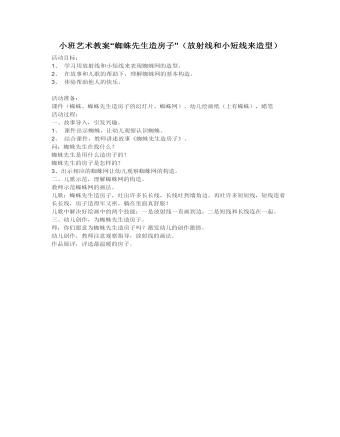
小班艺术教案“蜘蛛先生造房子”(放射线和小短线来造型
2、 在故事和儿歌的帮助下,理解蜘蛛网的基本构造。 3、 体验帮助他人的快乐。 活动准备: 课件(蜘蛛、蜘蛛先生造房子的幻灯片、蜘蛛网)、幼儿绘画纸(上有蜘蛛),蜡笔 活动过程: 一、故事导入,引发兴趣。 1、 课件出示蜘蛛,让幼儿观察认识蜘蛛。 2、 结合课件,教师讲述故事《蜘蛛先生造房子》。 问:蜘蛛先生在找什么? 蜘蛛先生是用什么造房子的? 蜘蛛先生的房子是怎样的? 3、出示相应的蜘蛛网让幼儿观察蜘蛛网的构造。
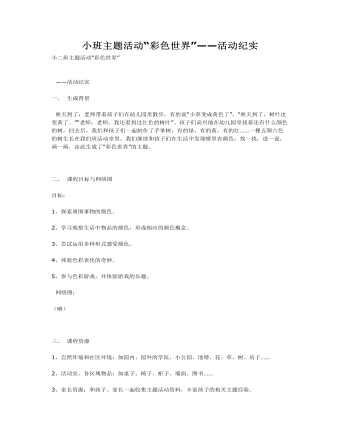
小班主题活动“彩色世界”——活动纪实课件教案
一、 生成背景 秋天到了,老师带着孩子们在幼儿园里散步,有的说“小草变成黄色了”,“秋天到了,树叶也变黄了。”“老师,老师。我还看到过红色的树叶”。孩子们高兴地在幼儿园里找着还有什么颜色的树,回去后,我们和孩子们一起制作了手掌树,有的绿,有的黄,有的红……一棵五颜六色的树生长在我们班活动室里。我们继续和孩子们在生活中发现哪里有颜色,找一找,说一说,画一画,由此生成了“彩色世界”的主题。 二、 课程目标与网络图 目标: 1、探索周围事物的颜色。 2、学习观察生活中物品的颜色,形成相应的颜色概念。 3、尝试运用多种形式感受颜色。 4、体验色彩表化的奇妙。 5、参与色彩游戏,并体验游戏的乐趣。
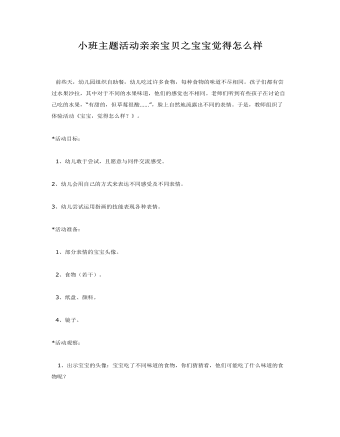
小班主题活动亲亲宝贝之宝宝觉得怎么样课件教案
活动目标: 1、幼儿敢于尝试,且愿意与同伴交流感受。2、幼儿会用自己的方式来表达不同感受及不同表情。3、幼儿尝试运用指画的技能表现各种表情。*活动准备: 1、部分表情的宝宝头像。 2、食物(若干)。 3、纸盘、颜料。 4、镜子。

中班语言《大灰狼娶新娘》说课稿
结合故事绘本教师讲述故事,了解主要内容。1、是谁要结婚啦?他的新娘是谁呢?引导幼儿充分地发言,激发幼儿的学习兴趣。2、大灰狼究竟想了什么办法呢?会对新娘说什么?(幼儿学说句式:新娘,新娘,请伸出手来看看。)新娘的手长得怎么样?3、大灰狼还猜不出新娘是谁,瞧,他又叫新娘伸出了什么?他会怎样问新娘呢?大灰狼说了什么?(幼儿学说句式:新娘,新娘,请伸出脚来看看。)新娘的脚长得怎么样?4、大灰狼还是不敢确定自己的新娘是谁,他又会请新娘伸出什么呢?大灰狼说了什么?(幼儿学说句式:新娘,新娘,请伸出尾巴来看看。)新娘的尾巴长得怎么样?5、大灰狼最后又会请新娘伸出什么呢?大灰狼说了什么?(幼儿学说句式:新娘,新娘,请伸出嘴巴来看看。)新娘的嘴巴长得怎么样?6、大灰狼的新娘有着长满毛的手、尖尖爪子的脚、又粗又长的尾巴、还有一张长着尖牙齿、红舌头的嘴巴,她到底是谁呀?教师揭示谜底。
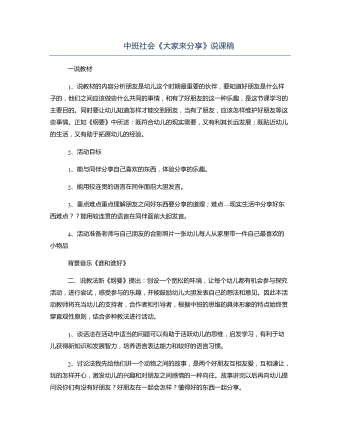
中班社会《大家来分享》说课稿
1、我先讲故事给幼儿听,让他们理解朋友的含义老师出示与朋友合影的照片,讲一讲与好朋友在一起的情景,趣事。(突出一起分享主题)幼儿讨论:好朋友在一起应该怎样?懂得好东西一起分享。介绍自己的小物品,尝试与朋友分享。今天小朋友们都把自己喜欢的小物品带来了,请你给大家说说你的物品是什么?怎样玩?你们带来的小物品太好玩了,你的朋友也想玩一玩,快去找个朋友交换着玩,这样你就会有更多个玩具了。播放背景音乐,引导幼儿自由结伴交换物品进行分享。老师注意引导幼儿能和更多的小朋友进行分享,进一步体会到分享的意义。讲一讲分享中发生的趣事,体验分享的乐趣。你和谁交换的,你们是怎样玩的?心里有什么感觉?有不愉快的事情发生吗?你们是怎样解决的?
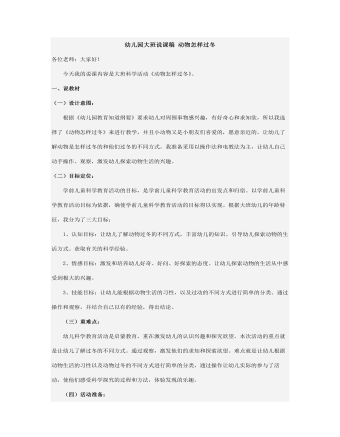
幼儿园大班说课稿 动物怎样过冬
根据《幼儿园教育知道纲要》要求幼儿对周围事物感兴趣,有好奇心和求知欲,所以我选择了《动物怎样过冬》来进行教学,并且小动物又是小朋友们喜爱的,愿意亲近的。让幼儿了解动物是怎样过冬的和他们过冬的不同方式。我准备采用以操作法和电教法为主,让幼儿自己动手操作、观察,激发幼儿探索动物生活的兴趣。 学前儿童科学教育活动的目标,是学前儿童科学教育活动的出发点和归宿。以学前儿童科学教育活动目标为依据,确使学前儿童科学教育活动的目标得以实现。根据大班幼儿的年龄特征,我分为了三大目标: 1、认知目标:让幼儿了解动物过冬的不同方式,丰富幼儿的知识。引导幼儿探索动物的生活方式。获取有关的科学经验。 2、情感目标:激发和培养幼儿好奇、好问、好探索的态度。让幼儿探索动物的生活从中感受到极大的兴趣。 3、技能目标:让幼儿能根据动物生活的习性,以及过动的不同方式进行简单的分类。通过操作和观察,并结合自己以有的经验,得出结论。
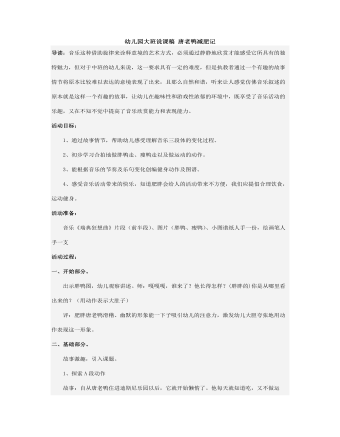
幼儿园大班说课稿 唐老鸭减肥记
音乐这种借助旋律来诠释意境的艺术方式,必须通过静静地欣赏才能感受它所具有的独特魅力,但对于中班的幼儿来说,这一要求具有一定的难度,但是执教者通过一个有趣的故事情节将原本比较难以表达的意境表现了出来,且那么自然和谐,听来让人感觉仿佛音乐叙述的原本就是这样一个有趣的故事,让幼儿在趣味性和游戏性浓郁的环境中,既享受了音乐活动的乐趣,又在不知不觉中提高了音乐欣赏能力和表现能力。 1、通过故事情节,帮助幼儿感受理解音乐三段体的变化过程。 2、初步学习合拍地做胖鸭走、瘦鸭走以及做运动的动作。 3、能根据音乐的节奏及乐句变化创编健身动作及图谱。 4、感受音乐活动带来的快乐,知道肥胖会给人的活动带来不方便,我们应提倡合理饮食,运动健身。
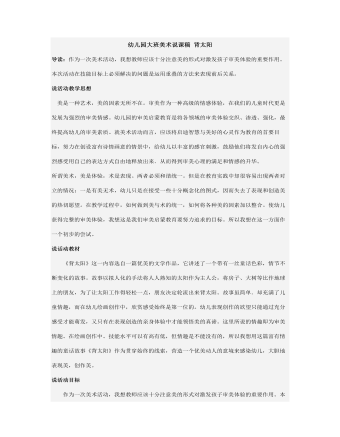
幼儿园大班美术说课稿 背太阳
美是一种艺术,美的因素无所不在。审美作为一种高级的情感体验,在我们的儿童时代更是发展为强烈的审美情感。幼儿园的审美启蒙教育是将各领域的审美体验交织、渗透、强化,最终提高幼儿的审美素质。就美术活动而言,应该将启迪智慧与美好的心灵作为教育的首要目标,努力在创设富有诗情画意的情景中,给幼儿以丰富的感官刺激,鼓励他们将发自内心的强烈感受用自己的表达方式自由地释放出来.从而得到审美心理的满足和情感的升华。所谓美术,美是体验,术是表现。两者必须和谐统一。但是在教育实践中却很容易出现两者对立的情况:一是有美无术,幼儿只是在接受一些十分概念化的图式,因而失去了表现和创造美的热切愿望。在教学过程中,如何做到美与术的统一,如何将各种美的因素加以整合。使幼儿获得完整的审美体验,我想这是我们审美启蒙教育要努力追求的目标。所以我想在这一方面作一个初步的尝试。
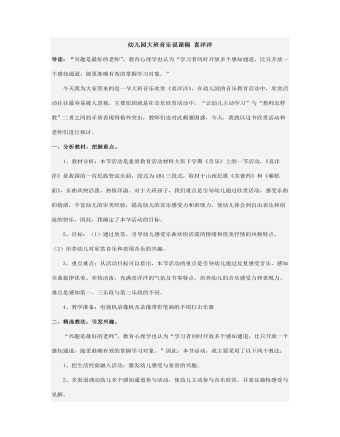
幼儿园大班音乐说课稿 喜洋洋
1、教材分析:本节活动是素质教育活动材料大班下学期《音乐》上的一节活动,《喜洋洋》是我国的一首民族管弦乐曲,段式为ABA三段式,取材于山西民歌《卖膏药》和《碾糕面》,乐曲欢快活泼、热情洋溢。对于大班孩子,我们重点是引导幼儿通过欣赏活动,感受乐曲的情绪,丰富幼儿的审美经验,提高幼儿的音乐感受力和表现力,使幼儿体会到自由表达和创造的快乐,因此,我确定了本节活动的目标。 2、目标:(1)通过欣赏,引导幼儿感受乐曲欢快活泼的情绪和优美抒情的风格特点。(2)培养幼儿对欣赏音乐和表现音乐的兴趣。 3、重点难点:从活动目标可以看出,本节活动的重点是引导幼儿通过反复感受音乐,感知全曲旋律优美、欢快活泼,充满喜洋洋的气氛及节奏特点,培养幼儿的音乐感受力和表现力。难点是感知第一、三乐段与第二乐段的不同。 4、教学准备:电视机录像机及录像带彩笔画纸手绢打击乐器
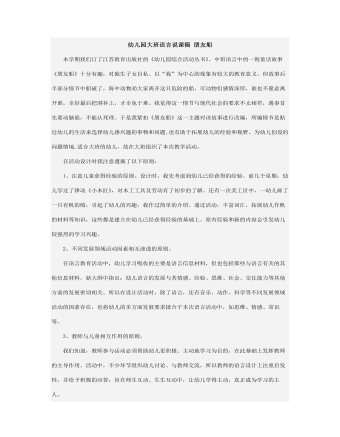
幼儿园大班语言说课稿 朋友船
本学期我们订了江苏教育出版社的《幼儿园综合活动丛书》。中班语言中的一则童话故事《朋友船》十分有趣,对独生子女自私、以“我”为中心的现象有较大的教育意义。但故事后半部分情节中船破了,海中动物劝大家离开这只危险的船,可动物们感情深厚,谁也不愿意离开谁,幸好最后把洞补上,才幸免于难。我觉得这一情节与现代社会的要求不太相符,遇事首先要动脑筋,不能认死理。于是我紧扣《朋友船》这一主题对该故事进行改编,所编情节是贴近幼儿的生活来选择幼儿感兴趣的事物和问题,也有助于拓展幼儿的经验和视野。为幼儿创设的问题情境,适合大班的幼儿,故在大班组织了本次教学活动。 1、注意儿童获得经验的原则。设计时,我先考虑到幼儿已经获得的经验。前几个星期,幼儿学过了律动《小木匠》,对木工工具及劳动有了初步的了解。还有一次美工区中,一幼儿画了一只有帆的船,引起了幼儿的兴趣,我作过简单的介绍。通过活动,丰富词汇,拓展幼儿作帆的材料等知识,这些都是建立在幼儿已经获得经验的基础上。原有经验和新的内容会引发幼儿较强烈的学习兴趣。
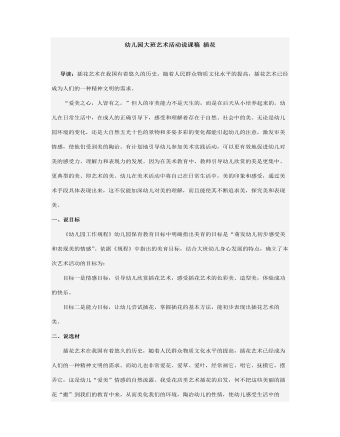
幼儿园大班艺术活动说课稿 插花
插花艺术在我国有着悠久的历史,随着人民群众物质文化水平的提高,插花艺术已经成为人们的一种精神文明的需求。 “爱美之心,人皆有之。”但人的审美能力不是天生的,而是在后天从小培养起来的。幼儿在日常生活中,在成人的正确引导下,感受和理解着存在于自然、社会中的美。无论是幼儿园环境的变化,还是大自然五光十色的景物和多姿多彩的变化都能引起幼儿的注意,激发审美情感,使他们受到美的陶治。有计划地引导幼儿参加美术实践活动,可以更有效地促进幼儿对美的感受力、理解力和表现力的发展。因为在美术教育中,教师引导幼儿欣赏的美是更集中、更典型的美、即艺术的美。幼儿在美术活动中将自己在日常生活中,美的印象和感受,通过美术手段具体表现出来,这不仅能加深幼儿对美的理解,而且能使其不断追求美,探究美和表现美。
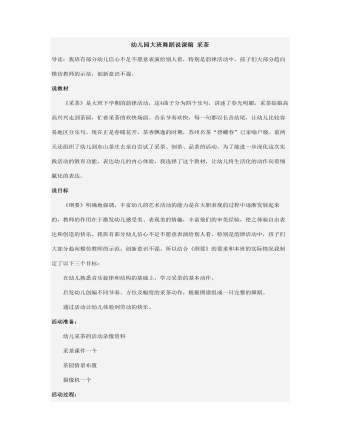
幼儿园大班舞蹈说课稿 采茶
《采茶》是大班下学期的韵律活动,这4曲子分为四个乐句,讲述了春光明媚,采茶姑娘高高兴兴走到茶园,忙着采茶的欢快场面。音乐节奏欢快,每一句都以长音结尾,让幼儿比较容易地区分乐句。现在正是春暖花开,茶香飘逸的时期,苏州名茶“碧螺春”已家喻户晓。前两天还组织了幼儿到东山茶庄去亲自尝试了采茶、制茶、品茶的活动。为了能进一步深化这次实践活动的教育功能,表达幼儿的内心体验,我选择了这个教材,让幼儿将生活化的动作向着细腻化的表达。 《纲要》明确地强调,丰富幼儿的艺术活动的能力是在大胆表现的过程中逐渐发展起来的,教师的作用在于激发幼儿感受美、表现美的情趣,丰富他们的审美经验,使之体验自由表达和创造的快乐。我班有部分幼儿信心不足不愿意表演给别人看,特别是韵律活动中,孩子们大部分趋向模仿教师的示范,创新意识不强。所以结合《纲要》的要求和本班的实际情况我制定了以下三个目标: 在幼儿熟悉音乐旋律和结构的基础上,学习采茶的基本动作。 启发幼儿创编不同节奏、方位及幅度的采茶动作,根据图谱组成一只完整的舞蹈。 通过活动让幼儿体验到劳动的快乐。

